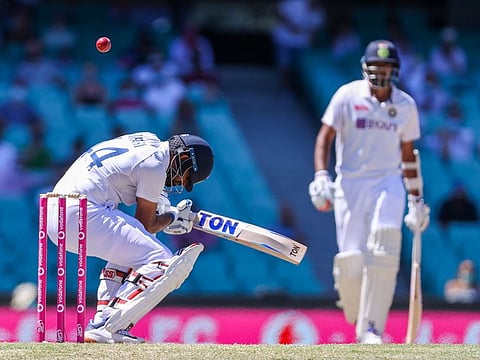Sydney Test: Indian batsmen rekindle romance of the fifth day
Four-Test series now headed for a befitting climax at Brisbane

Kolkata: There is something about the fifth day of a Test match - either it can keep the fans on the edge of their seats in anticipation for hours or turn them away in exasperation while a predictable draw looms large on the horizon. The one on Monday in Sydney was of the first variety, which showed how knee-jerk it will be for the guardians of the game to even contemplate making it a four-day affair.
When India started the final day at 98 for two - with another 309 runs to get for an improbable win - not the most diehard of their supporters gave them a chance of getting there as it seemed more pragamtic to save the game and move on to the Brisbane Test with the series at 1-1. History, meanwhile, was also against them as no team ever scored more than 288 in the fourth innings at Sydney to record a win.
At the end of the day, the injury-wrecked Indian batsmen rose to the occasion to end the Test with an extremely creditable draw, not to speak of the occasional ‘what ifs’ if the belligerent Rishabh Pant could have completed his well-deserved century and carried on for some more time. Pilloried after dropping catches in both Australian innings, the 22-year-old came out to bat at number five with a hurt elbow and deserves a big round of applause for the way he took the fight to the opposite camp under such a pressure situation.
There will be some room for criticism for the way the young wicketkeeper left his crease to the wily Nathan Lyon for an avoidable pull shot only to be caught by Pat Cummins for 97, but it was his role of an aggressor in an invaluable 148-run partnership with Cheteshwar Pujara which raised India hopes of saving the Test match.
A successful team needs it’s stroke makers like a Rohit Sharma or the effervescent Pant, just like it needs it’s working class heroes like Pujara or Hanuma Vihari. Pulled up so often for his scoring rates and being subjected to often unfair criticism with Rahul Dravid, Pujara proved his worth again with monumental patience during his innings of 70 and in the bargain became the 11th Indian to score 6000 Test runs.
Having taken 134 innings to reach the landmark, Pujara became the sixth-fastest among Indian batsmen after Sunil Gavaskar (117), Virat Kohli (119), Sachin Tendulkar (120), Virender Sehwag (123) and Rahul Dravid (125) - not a bad job for the reticent 32-year-old batsman from Saurashtra who may lack the charisma of the members of the elite club but was worth his wait in gold in the format. The other Indian batsmen who have achieved the feat are VVS Laxman, Sourav Ganguly, Dilip Vengsarkar, Mohammad Azharuddin and Gundappa Viswanath.
The unassuming Vihari, whose 23 off 161 balls while nursing a hamstring injury may not still be enough to guarantee him a place in the Test squad against England at home, played as much a role in saving the match as the seasoned Ravi Ashwin (39). A former ICC Test Player of the Player, Ashwin brought back the basics about the art of survival on a fifth day wicket and the 50-plus partnership between the duo can never be measured in terms of runs.
This Test series is living up to be a fine example of what they call a ‘‘great advertisement for Test cricket,’’ if one keeps aside the racism incident as a little spoiler.
Over then, to Brisbane for the final round!
Sign up for the Daily Briefing
Get the latest news and updates straight to your inbox






